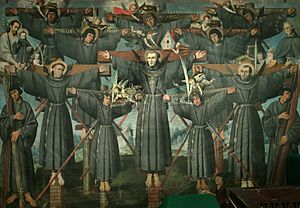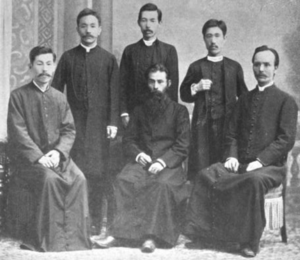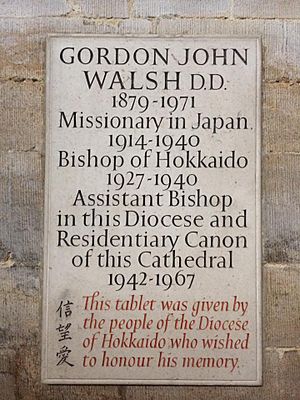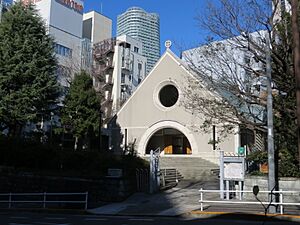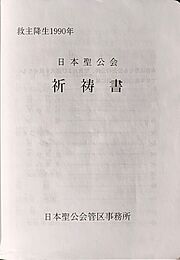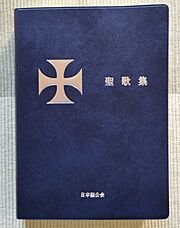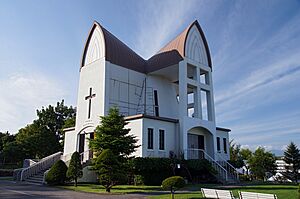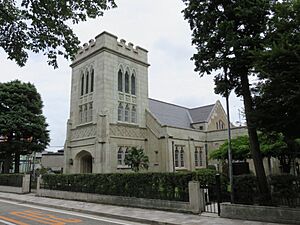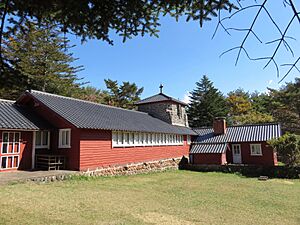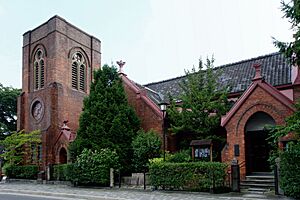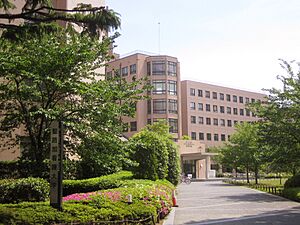Anglican Church in Japan facts for kids
Quick facts for kids Nippon Sei Ko Kai |
|
|---|---|
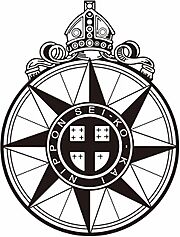 |
|
| Classification | Protestant |
| Orientation | Anglican |
| Scripture | Holy Bible |
| Theology | Anglican doctrine |
| Polity | Episcopal |
| Primate | David Eisho Uehara |
| Headquarters | 65 Yaraicho, Shinjuku-ku, Tokyo |
| Territory | Japan |
| Members | 58,000 |
The Nippon Sei Ko Kai (pronounced Nee-pon Say-koh-kai), often called the Anglican Episcopal Church in Japan, is the official Christian church for the Anglican faith in Japan. It's part of a big worldwide family of churches called the Anglican Communion.
As a member of the Anglican Communion, the Nippon Sei Ko Kai shares many traditions with the Church of England. These include its beliefs and how it conducts church services. However, it is a fully independent church in Japan. It has its own leaders and makes its own rules. The Nippon Sei Ko Kai sees itself as both "Catholic" (meaning universal and ancient) and "Reformed" (meaning it has changed some things from older traditions).
The Anglican Communion is the third largest Christian group in the world. It has about 80 million members. The Nippon Sei Ko Kai has around 58,000 members across Japan. These members are organized into eleven different areas called dioceses.
Contents
History of the Church in Japan
Early Christianity in Japan (1549–1846)
Christianity first came to Japan in the 1500s. Saint Francis Xavier, a Jesuit missionary, arrived with Portuguese explorers. However, in 1587, the Christian faith was banned. Christians, both Japanese and foreign, faced harsh treatment. The Nippon Sei Ko Kai remembers these early Japanese Christians every year on February 5. They honor them for their strong faith.
Later, in 1640, all foreigners were sent away from Japan. Japan then closed itself off from the rest of the world for about 200 years. During this time, Christian communities had to practice their faith in secret. When foreigners were allowed back in the 1850s, they found thousands of Japanese Christians. These Christians had kept their faith alive for centuries, even during persecution.
Anglican Mission Begins (1846–1900)
Anglican church work in Japan began in 1846. The first Anglican burial service on Japanese soil happened in Yokohama in 1854. This was led by George Jones, a United States Navy chaplain. More permanent missionaries arrived in 1859. These included John Liggins and Channing Moore Williams from the American Episcopal Church.
At first, missionaries could only serve foreign residents. This was because the Japanese government restricted teaching Christianity. Also, there was a big language barrier. The first Japanese person to be baptized by Williams was in 1866.
More missionaries from the Church Mission Society (Church of England) arrived in 1869. After the Meiji Restoration, Japan became more open. New laws allowed more religious freedom. This led to more missionaries arriving in Tokyo in 1873.
By 1879, much of the Book of Common Prayer was translated into Japanese. The full version was ready by 1882. In 1883, the first Japanese deacons were ordained. These were Nobori Kanai and Masakazu Tai. The Anglican Church of Canada also started missionary work in Japan in 1888.
Many lay missionaries (people who are not ordained clergy) also helped the church grow. They started schools, universities, and hospitals. Important women missionaries included Ellen G. Eddy, Alice Hoar, and Florence Pitman. Hannah Riddell and Mary Cornwall-Legh were honored by the Japanese government. They both set up hospitals for people with leprosy.
The first meeting of the Nippon Sei Ko Kai happened in Osaka in 1887. At this meeting, different Anglican missions decided to join together. They formed one independent national church. This was the Nippon Sei Ko Kai. There were 17 European and American participants. But there were also 14 Japanese clergy and 50 Japanese lay delegates.
In 1887, the church had about 1,300 members. John Toshimichi Imai became the first Japanese Anglican priest in 1889.
Growth and Challenges (1900–1945)
By 1906, the Nippon Sei Ko Kai had grown to 13,000 members. Many leaders believed that an independent, Japanese-led church was essential. This would help Christianity spread across Japan. The first Japanese bishops were consecrated in 1923. These were John Yasutaro Naide and Joseph Sakunoshin Motoda.
In the 1930s, Japan saw a rise in militarism. The government also promoted Shinto as a state religion. Christianity was sometimes seen as disloyal to Japan. The Nippon Sei Ko Kai sometimes issued statements supporting the Imperial Army. The church also expanded overseas during this time. It helped establish churches in Taiwan, Manchuria, and Korea.
However, the government began persecuting Christians more actively in 1937. This was especially true for churches with ties to other countries. The Archbishop of Canterbury criticized Japan's actions in China. This led to more scrutiny of the NSKK. Some church leaders tried to distance themselves from the wider Anglican Communion.
During World War II, the Japanese government forced most Protestant churches to join the United Church of Christ in Japan. But many Nippon Sei Ko Kai churches refused to join. This resistance led to harassment by military police. Some church leaders, like Bishops Samuel Heaslett and Todomu Sugai, were imprisoned.
Many church buildings, hospitals, and schools were destroyed during the war. For example, St. Andrew's Cathedral, Tokyo, was lost in the 1945 Allied bombing.
Post-War Recovery (1945–Present)
The war caused great damage to the church. Seventy-one of its 246 churches were destroyed. Others were in poor condition.
After the war, the Nippon Sei Ko Kai began to rebuild. With support from the Archbishop of Canterbury, the church was reorganized in 1947. Japanese bishops now led each diocese.
In 1948, Presiding Bishop Yashiro gave a beautiful silk robe and hat to Archbishop Fisher. This was a thank-you gift from the NSKK. It showed the strong connection between Anglican churches worldwide. The Archbishop wore this robe at important events, including the Coronation of Queen Elizabeth II in 1953.
The Nippon Sei Ko Kai became financially independent in 1972. In 1996, the church formally apologized for its role in Japan's wartime actions. Since then, it has worked on projects promoting peace and reconciliation in East Asia.
In December 1998, Margaret Ryoko Shibukawa became the first woman priest in the Nippon Sei Ko Kai.
The church celebrated its 150th anniversary in 2009. Important Anglican leaders from around the world visited Japan for the occasion. In 2013, the NSKK co-hosted a peace conference in Okinawa.
The Church Today
Luke Kenichi Muto, Bishop of Kyushu, became the head of the Nippon Sei Ko Kai in November 2020. He was succeeded by Bishop David Eisho Uehara of Okinawa in 2024.
Today, the Nippon Sei Ko Kai continues its work in Japan. It supports church communities, hospitals, and schools. It also advocates for disadvantaged people. The church helps communities affected by the 2011 Great East Japan earthquake and tsunami.
The NSKK also does mission work in other countries, like the Philippines.
Eight of the NSKK's dioceses allow women to become deacons and priests. Women have been ordained as deacons since 1978 and as priests since 1998. Margaret Shibukawa Ryoko was the first woman deacon and priest. In 2021, Grace Trazu Sasamori was elected as the first woman bishop in the church.
Worship Practices
The main prayer book used in services is called Ki Tō Sho. Its latest version, from 2000, includes the Lord's Prayer wording. This wording is also used by the Catholic Church in Japan.
The Bible readings in church mostly come from the Japan Bible Society Interconfessional Version (2018). The church's hymn book is called Sei Ka Shū (2006).
Dioceses and Churches
The Nippon Sei Ko Kai has eleven dioceses. There are over three hundred churches and chapels across Japan. Here are some notable churches in each diocese:
Hokkaido Diocese
The Anglican mission in Hokkaido began in 1874. Missionaries like Rev. Walter Dening and Rev. John Batchelor helped the Ainu people. Today, the Diocese of Hokkaido has 24 churches, 5 kindergartens, and 4 nursery schools.
Maria Grace Tazu Sasamori became the bishop of Hokkaido in 2022. She is the first female bishop in the NSKK.
Tohoku Diocese
The Anglican mission to the Tohoku Region (Northeast Japan) started in 1891. The first church building in Sendai was finished in 1905. The Christ Church Cathedral, Sendai was rebuilt in 1965 and again in 2014 after being destroyed in World War II.
Kitakanto Diocese
The first Anglican mission in the Diocese of Kitakanto began in 1878. This diocese covers Ibaraki, Tochigi, Gunma, and Saitama Prefectures. In 1901, the first church-affiliated kindergarten opened in Kawagoe. Mary Cornwall Legh also started a medical unit for leprosy patients in Kusatsu in 1916.
Tokyo Diocese
The Diocese of Tokyo was officially formed in 1923. It has 33 churches and 9 chapels. Many of these were first built in the late 1800s.
- St. Andrew's Cathedral, Minato-ku, Tokyo
- St. Alban's, Minato-ku, Tokyo, an English-speaking church next to St. Andrew's Cathedral.
- St. Luke's Chapel, Chuo-ku, Tokyo, located in St. Luke's International Hospital. This was one of the few NSKK churches in central Tokyo to survive World War II.
Yokohama Diocese
- St. Andrew's Cathedral, Yokohama
- Christ Church, Yokohama, a famous church overlooking the Port of Yokohama. It has both English and Japanese services.
- St. Andrew's Church, Kiyosato, Yamanashi
Chubu Diocese
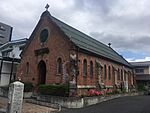
The Diocese of Chubu covers four prefectures in Central Japan. The Anglican Church of Canada helped establish this diocese. The Nagano Holy Saviour Church was built by Canadian missionary J. G. Waller. It is now an important cultural property.
The current bishop is Dr. Renta Nishihara.
Kyoto Diocese
- St. Agnes' Cathedral, Kyoto
Osaka Diocese
- Christ Church Cathedral, Kawaguchi, Osaka, the main church for the Bishop of Osaka.
Kobe Diocese
- St. Michael's Cathedral, Kobe
Kyushu Diocese
- St. Paul's Cathedral, Fukuoka
Okinawa Diocese
Church Facilities
The Nippon Sei Ko Kai runs over two hundred educational, medical, and social welfare institutions in Japan.
Seminaries
- Central Theological College, Tokyo: This college trains future priests. It was founded in 1908.
- Williams Theological Seminary, Kyoto
Religious Orders
- Community of Nazareth, Tokyo: This is a group of Anglican religious sisters. It was started in 1936.
Universities and Colleges
- Rikkyo University, Tokyo (also known as St. Paul's University)
- St. Margaret's Junior College, Tokyo
- St. Mary's College, Nagoya
- Momoyama Gakuin University, Osaka (also known as Saint Andrew's University)
- Heian Jogakuin University, Kyoto and Osaka (also known as St. Agnes University)
- Poole Gakuin University, Osaka
- Poole Gakuin Junior College, Osaka
- Kobe International University, Kobe
- Kobe Shoin Women's University, Kobe
Hospitals
- St. Luke's International Hospital, Tokyo
- St. Barnabas' Hospital, Osaka
Notable People in NSKK History
Early Leaders (1859–1900)
- Channing Moore Williams (1829–1910): An early Episcopal Bishop and founder of Rikkyo University.
- John Liggins (1829–1912): The first Anglican missionary in Japan.
- Alexander Croft Shaw (1846–1902): A missionary who founded St. Andrew's Church in Tokyo.
- John Batchelor (1854–1944): A missionary who worked with the Ainu people in Hokkaido.
- John Toshimichi Imai (1863–1919): The first Japanese person to become an Anglican priest in 1889.
Leaders During Growth and War (1900–1945)
- Paul Shinji Sasaki (1885–1946): A Bishop and later the head of the Nippon Seikokai.
- Joseph Sakunoshin Motoda (1862–1928): A Bishop of Tokyo.
- Mary Cornwall Legh (1857–1941): A missionary who cared for people with leprosy in Kusatsu.
- Paul Rusch (1897–1979): A lay missionary and educator who founded Seisen Ryo (KEEP).


